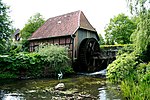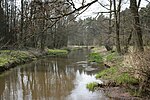Armoured Corps Training Centre (Germany)
1956 establishments in West GermanyBundeswehrGerman Army (1956–present)German military unit and formation stubsMilitary units and formations established in 1956
The Armoured Corps Training Centre (German: Ausbildungszentrum Panzertruppen) in Munster is one of the German Army's training centres (Zentren des Heeres) with particular responsibility for the basic and continuation training of armoured troops, including the armoured and the mechanized infantry corps of the German Army. By tradition, the centre is nicknamed the Armoured Corps School (Panzertruppenschule) whose tasks it partly subsumed on 1 October 2007.
Excerpt from the Wikipedia article Armoured Corps Training Centre (Germany) (License: CC BY-SA 3.0, Authors).Armoured Corps Training Centre (Germany)
Panzer-Ringstraße,
Geographical coordinates (GPS) Address Nearby Places Show on map
Geographical coordinates (GPS)
| Latitude | Longitude |
|---|---|
| N 52.982214 ° | E 10.118666 ° |
Address
Bundeswehr Tankstelle
Panzer-Ringstraße
29633
Lower Saxony, Germany
Open on Google Maps









